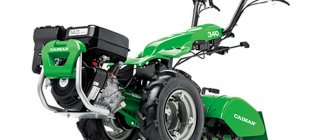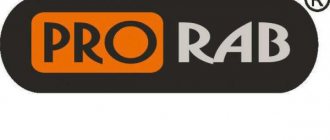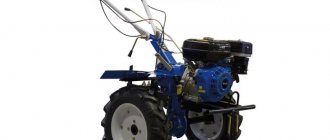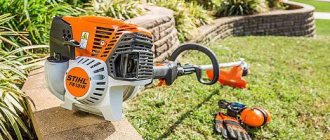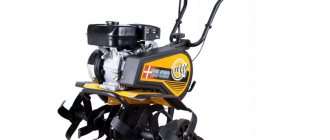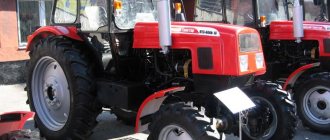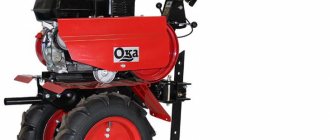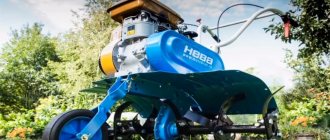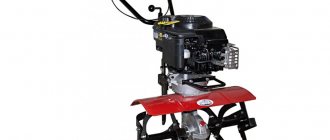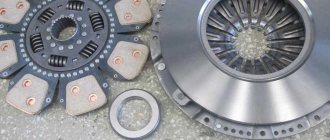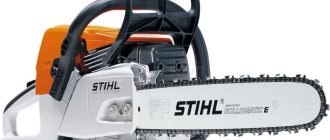The Cayman cultivator is a device from a well-known manufacturer of gardening equipment for complex cultivation of land plots. With its help, you can loosen the soil, prepare furrows before planting potatoes or grain crops, remove weeds, and also hill up fruit crops.
A wide range of devices makes it possible to choose the appropriate model, regardless of the area of the site, type of soil and planned tasks.
Motor cultivators Cayman
The Caiman cultivator is a high-quality product of collaboration between Japanese and French engineers. The history of the brand begins in 2004, when Pubert began collaborating with Subaru, which was developing a new direction - the production of engines for garden equipment. The result met expectations - gardening equipment produced under the Caiman brand is distinguished by high build quality, ease of use, ease of operation, and reasonable prices. The same applies to Cayman cultivators with Subaru engines.
bought a CAIMAN ECO 50S C2 motor cultivator, impressions
We bought a dacha plot of 15 acres. No work has been carried out on the site for the last 2-3 years, so it is a completely overgrown field. The burdock grows (more than 2 meters in height, the trunk is almost as thick as the handle of a shovel), a bush (not tall, but with very stiff stems emerging from the ground in a bunch) and ordinary weeds. The first day was an attempt at clearing by hand - the burdock was chopped with an ax, the bushes were cut with garden shears. In principle, you can remove everything in a month, but it’s very difficult. After reading this forum, the decision was made to purchase a brush cutter (I immediately purchased an additional cutting disc). One day of working with a lawn mower (for the first time in my life), of course only with a disc and the area was mowed. Only the roots and trunks remained, somewhere at a level of 10-15 cm above the ground. The question arose about digging up the entire dacha. It’s hard to do it manually, there are no southern workers nearby, and it was decided to buy a motor cultivator. Average in weight, power and price. After reviewing all the forums (about a dozen), and reading a bunch of reviews, we settled on the PUBERT ELITE 65B C2 model for RUB 27,990.00. But it turned out that it was not available in Samara. (On advice from the forum, I decided not to buy in stores like Leroy and Castorama.) There was a very good choice in Enthusiast stores and there the seller (very smart) persuaded me to buy the CAIMAN ECO 50S C2 model for 25,990.00 rubles. The main arguments were the same manufacturer, the Japanese SUBARU-ROBIN engine and a 2-year warranty. They poured oil, splashed gasoline, started it up and handed me this unit. The question arose - how to transport it? The Nissan Qashqai is not the smallest car, but it was difficult for the cultivator to fit into the trunk at the back. I had to remove the trunk shelf and the steering wheel of the cultivator. The CAIMAN stands very unstable in the car, rests on a couple of cutter teeth and sways when driving. I had to cover it with different things, and put hard objects (such as an ax) under the teeth. I started reading the instructions - a rather stupid thing. Common for all modifications and for different engines. And they have differences in management. And most importantly, there is not a word about working with the motor cultivator itself. I had to read the forum again and download a couple of instructions from other motor cultivators to understand how the cultivation process occurs. I dug the ground twenty years ago, but I’ve never had anything to do with cultivators. So, we arrived at the dacha. First: we have difficulty getting the cultivator (almost 50 kg) out of the trunk (I take out the cultivator, and my wife takes out the steering wheel with control cables). Second: we fasten this steering wheel (here we need more wrenches - to keep the bolt itself from turning), install protective fenders (there were no small wrenches - I tightened the nuts by hand). We fill up with 92 gasoline. We lift the transport wheel (after an hour of work, the axle or bolt was lost and the wheel stopped holding down). That's it, you can try. It started right up, warmed it up at medium speed for about five minutes and off it went. The first minutes of work are the most difficult, nothing works, he doesn’t really plow, he jumps like a goat and rushes forward. It leaves a trail behind it like a rake. My wife is shocked, and so am I. We bought it... But then we started to adapt. You press the coulter (the piece of iron at the back) and the cultivator slows down and begins to go deeper. The place under the burdock (there is no grass) goes 10-15 centimeters deep easily, where there are hard roots - it jumps, you press the coulter into the ground and the cultivator begins to chisel these roots. I often had to clean the cutters from the roots - the cutters are not sharp and pull everything out. The device is powerful - it even tears aluminum wire. In 5 hours we covered the entire section. Where there is dense weed grass, it takes 5-8 centimeters, you need to go through it a couple of times. Everything is fine, just inconvenient transportation. Before work, it is better to cut off all the powerful roots with a shovel - the work will become much easier. Reverse is really needed, sometimes you miss a piece - you can return. It is very inconvenient to handle uneven places, holes, ditches. You have to move the device a lot. It’s hard for a woman to work alone. Everything is fine, just inconvenient transportation. Bottom line: it’s worth taking a motorized cultivator, but it’s better to measure its dimensions in a store with a tape measure and figure out how to transport it (the option in the back seat is good, but dirty).
Description and main characteristics
Let's look at the characteristics and distinctive features of the most popular models of Cayman cultivators.
Caiman Eco Max 50S C2
A productive cultivator equipped with a 4-stroke Subaru gasoline engine with a power of 5 hp. With. Three pairs of soil cutters, made of hardened steel, ensure high-quality plowing of the land, regardless of the type of soil. Side discs prevent accidental damage to ornamental plants and flowers. The tillage width is 600 mm, with a plowing depth of 320 mm.
The distinctive features of the model include:
- The presence of a reverse gear increases maneuverability and facilitates work in areas with difficult terrain;
- Ergonomically shaped handle that is height adjustable in three positions;
- A reliable, collapsible chain gearbox ensures high-quality transmission of torque from the engine with minimal power loss;
- Adjustable plowing width;
- Reliable Japanese engine from Subaru with timing chain drive.
The functionality of the cultivator can be expanded through the use of auxiliary attachments - a hiller, a plow, a potato digger or a weeder. It is also possible to install lugs with weights and a trolley. Installation of attachments is carried out using a hitch.
The recommended cultivation area for the Caiman Eco Max 50S C2 cultivator is 1500 m2.
Caiman Trio 70 C3
A new generation cultivator characterized by good performance and economical fuel consumption. The model is recommended for processing areas up to 2000 m2. The plowing width is adjustable from 300-900 mm with a depth of up to 320 mm.
A distinctive feature of the Caiman Trio 70 C3 cultivator is reverse gear with a speed of 0.7 m/s, which facilitates efficient and safe work in hard-to-reach places.
Model design features:
- Powerplant – Caiman Green Engine 212CC is a premium class engine. Thanks to a well-thought-out air purification system, the device can be operated even in very dusty conditions. The design of the combustion chamber promotes efficient combustion of the air-fuel mixture, reducing emissions of harmful substances into the atmosphere.
- Saber-shaped cutters made of hardened steel.
- Two forward gears for efficient work with both cutters and attachments.
- Belt clutch with a patented engagement system, thanks to which the belt does not slip over the roller, which increases the service life of the unit. A special lock is installed on the levers, which eliminates the possibility of accidental activation.
- Compact chain reducer of collapsible type;
- Double-sided coulter for adjusting the depth of processing of hard and wet soil.
Cultivator weight – 62 kg.
Caiman Mokko 40 C2
A new generation model, equipped with a 4-stroke gasoline internal combustion engine Caiman Green Engine 100CC, 4 hp. With. The power plant is distinguished by its quality of workmanship - cast iron liners and a forged crankshaft guarantee a long service life. The inclined position of the cylinders promotes efficient combustion of the fuel mixture, reducing the level of harmful emissions into the atmosphere.
Caiman walk-behind tractors and cultivators reviews
Cultivator Caiman NANO 40K reviews
Andrej Petelin ★★★★★ Advantages:
Small, light, strong, easy to transport.
Disadvantages:
none
Comment:
Works on two small garden plots, I often transport it in the trunk of a car when folded. Very light and maneuverable. At first he cultivated it himself, and then he “tamed” his mother-in-law to cultivate his flower beds. The Japanese 4-stroke Kawasaki engine consumes little gasoline and does not choke under load. For a couple of years I haven’t done any maintenance at all, except I checked the oil a couple of times and shook off the dirt!
Cultivator Caiman ECO 45R C2 reviews
Alexander P. ★★★★★ Advantages:
workhorse.gasoline consumption
Disadvantages:
the cable drives wear out over time.. I redid everything manually, the disks on the stumps are weakly attached - I had to digest it, the reverse gear in the box got stuck after a little use - it was fixed at the service station.. the belt cover is attached somehow poorly - on a wire fastened it, then removed it altogether
Comment:
this machine worked for itself and that guy a hundred times over... with such severe exploitation... it takes virgin land, plows everything
Motoblock Caiman Vario 60H reviews
Motoblock Caiman VARIO 60S TWK+ reviews
Mikhail I. ★★★★★ Advantages:
A 13 year old child starts the engine like a clock.
Moderately heavy. Cons:
Price, but worth it. 2 years ago this model was stolen. If it had been simpler, it probably wouldn’t have been stolen.
dimani ★★★★ Advantages:
Easy to use, excellent cultivation, reliable Japanese engine, gearbox, cutters.
Disadvantages:
Expensive drive belt costing 1200 rubles.
for the original, the speed switch sometimes sticks, transmission oil leaks in working condition. Comment:
I have been using this walk-behind tractor as a cultivator for the fourth season now. Quite pleased with the purchase. You need to get used to the CVT gearbox; when the gear shift gets stuck, you need to push the walk-behind tractor forward or backward a little, depending on the choice of driving mode. The Mitsuboshi LA45 drive belt (for agricultural machinery) is difficult to find on sale, so you have to buy an expensive original with the Pubert inscription. Otherwise, there are no complaints, only pleasant impressions from working with Caiman Vario!!!
Cultivator Caiman ELITE 60S D2 reviews
Vladlen K. ★★★★ Advantages:
1. reverse is a very necessary thing 2. changing the speed by changing the rotation speed of the cutter (gas) 3. on medium soil it does not goat, but on very dry soil it starts to go.
4.acceptable vibration (I work in old demi-season gloves) 5.ease of maintenance (oil change and spark plug maintenance) 6.AI-92 fuel I fill up on the way to the dacha in a separate canister 7.dimensions—I transport it in the trunk of a Sid SV without any problems 8.switch off working cultivator with a three-point lever is very convenient, because you don’t think about where to switch Disadvantages:
1. after the first season, the round stops flew off and the soil began to scatter more to the sides 2. after the second season, the engine began to run unevenly, the reason: the vacuum hose was weakened.
treatment: clamp. 3. additional hooks, plow, etc. I bought it, but I don’t use it because... standard milling cutters do everything, even on old arable land. Comment:
a plot of 25 acres on an abandoned field, very hard ground, Cayman coped without problems (not counting the round limiters, for which he took off 1 star). I couldn’t get the hang of driving the plow, the cutters can handle it, I just need to sharpen it. I'm now thinking of buying other cutters with triangular heels. I bought a Cayman before the crisis for 24,000, of course now I probably wouldn’t pay 40,000 for it
Cultivator Caiman TURBO 1000 reviews
Anastasia Ch. ★I had to take it in for repairs right away
Features of operation and maintenance
A lot of time has passed since the founding of the brand. The company is constantly working to expand its range and improve existing equipment. Despite the fact that assembly plants are now located in 16 countries around the world, Caiman continues to delight consumers with high-tech equipment that fully meets modern requirements.
All Cayman factories, regardless of geographical location, have a single quality standard, which virtually eliminates the possibility of defective products appearing on the market. Cayman gasoline cultivators equipped with engines from Subaru are distinguished by their reliability. As practice shows, subject to the provisions of the operating manual, the service life of cultivators significantly exceeds the 2500 hours declared by the manufacturer.
The main requirements of the manufacturer include:
- It is prohibited to use gasoline below grade AI 92. Failure to comply with this requirement will lead to dire consequences - breakdown of power system elements and a significant reduction in engine service life, including repair. Signs of refueling with substandard fuel are problems with starting, a noticeable decrease in power, interruptions in operation, increased consumption.
- Follow the maintenance schedule. In this case, you should use consumables recommended by the manufacturer. This also applies to engine and transmission oil.
- Do not store the cultivator outdoors. It should be under a shed or in a garage.
- Avoid the appearance of corrosion spots.
- Any operations, whether maintenance or repair, must not contradict the provisions of the operating instructions.
Motor cultivator PUBERT & CAIMAN
Greetings to forum participants! So to speak, welcome the new one... Recently I became the owner, I hope happy, of the above-mentioned device. First, I’ll try to justify my choice... Although I live in the city, I can’t say that I’m far from agriculture, because... my parents come from the village, my childhood was spent practically in the village and I still often go there, thank God my grandparents are still alive and, given their advanced age, they increasingly have to help both with the housework and in the garden... As for garden, the help was mainly limited to planting and harvesting crops (potatoes, beets, corn), all intermediate operations (weeding, hilling) were done by the grandmother herself... The wife’s situation is identical... In addition, there is a dacha of 6 acres and a vegetable garden of 8 acres with which my father “fought”... In general, of course, there is always not enough time, the villages (mine and my wife’s) are scattered at different ends of the region with all the ensuing consequences...
Based on the above, the task was set to speed up and facilitate all work related to the garden... Criteria: 1. MK must “master” a garden of about 10-15 acres in a day in the entire range of garden work; 2. (In principle, determining) The ability to transport the MK in a car (VAZ 2110); Considering point 2, walk-behind tractors are no longer needed... Of those represented in our region, and these are Pubert, Bolens, Al-Ko, Tarpan and several Chinese, the choice fell on Pubert. This was preceded by a month of constant surfing on the Internet and walking in circles between stores selling this equipment and contemplating how people scatter MKs named after this manufacturer so much so that you have to sign up for the next batch in advance, while MKs from other manufacturers are freely on sale ( not counting the Chinese, because of the relatively low price, they will also be scattered) ... The Chinese equipment somehow does not inspire confidence in me, so Pubert remained ... And since they had to be signed up for several weeks in advance, I had to take the one that was on the display case, more precisely, the one that was pulled out onto the street for advertising purposes. Considering that he was constantly dragged here and there, he was slightly scratched, for which he was knocked off 100 UAH. So it cost me 4950 UAH ($980)... Subaru 4.5 hp engine. with reverse. As for the reverse, the seller strongly advised to buy it with reverse (even if not Pubert, but definitely with reverse), for which I am sincerely grateful to him, given the operating experience I already have...
In general, the first testing ground was a vegetable garden in my native village. The soil is heavy - loam; before this they tried to cultivate it twice, but twice it was flooded by rain. The third time a neighbor tried to do something there with a horse and a harrow, but what he succeeded with can hardly be called a vegetable garden prepared for planting (it’s a pity I forgot to take a camera, otherwise I would have attached a photo report)… In general, the device I brought did not arouse much enthusiasm among old farmers (grandfather and grandmother), but since there was no other choice, given the state of their garden at that time, I was allowed to experiment... They filled in oil and gasoline - it started up with half a turn, let it work a little without load, and as they say in the field... Even taking into account , that this was my first experience with such equipment, I did not feel any particular difficulties in mastering it: MK confidently ran around the garden under my strict guidance (there is more than enough power despite the condition of the soil), changing my relatives’ opinion of themselves before our eyes... In about 20 minutes I prepared a bed of 2 acres for beans... In general, what happened before and what happened after simply cannot be compared: the soil was prepared, again, according to the estimates of optimists who already know a lot about this matter, at 5 plus... The next day, a similar The “fate” also befell the remaining 15 acres of the garden, after which the potatoes were successfully planted “under the plow” (still manual) without much effort; beets and corn were sown using a manual (I don’t know how to say it in Russian) beets and corn, before processing MK this device , which significantly speeds up the sowing process, was simply impossible to use...
PS First impressions are almost delightful, for everyone (especially the neighbors who walked around their gardens all day and beat the pile with shovels, and even with dubious results)... The reverse gear is generally super, considering the 50 kg weight of the MK, I can’t even imagine how it’s possible without him... The only difficulty, relative of course, was transportation again - I had to remove the engine (15-20 minutes of work), but then the MK fits in the trunk...
We are waiting for the next stage - weeding, hilling... And for this we will need to buy attachments... Therefore, the first question to the respected forum members will be: Grinders! Which ones to take (considering that later you will have to dig up potatoes - this means that you have read that the MK sits on the ridge with a gearbox) native ones or those with a larger diameter? Or or……..
Thanks in advance for your answers!
Advantages and disadvantages
The advantages of equipment produced under the Cayman brand include:
- A wide range of cultivators, which includes electric and gasoline models;
- Thanks to high performance and multi-speed gearboxes with reverse, the capabilities of some cultivators are comparable to walk-behind tractors of similar power;
- Reliable Subaru engines that meet modern environmental protection standards;
- Durable, certified Fast Gear gearboxes;
- Pricing policy aimed at consumers with average incomes.
Negative factors include strict requirements from manufacturers regarding the use of branded spare parts and consumables. For the sake of fairness, we note that the cost of original components is not much higher than available analogues.
